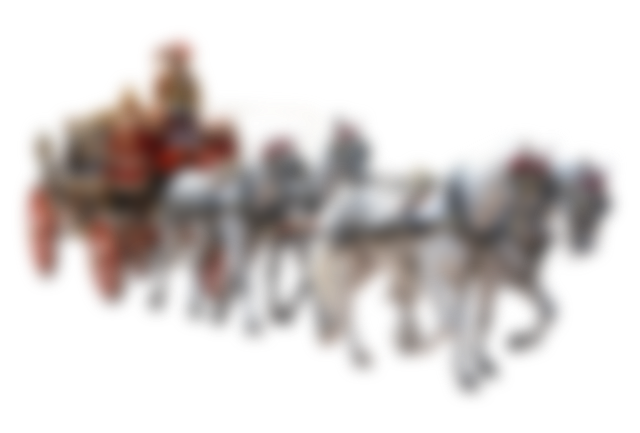The Royal Mews

The Royal Mews is concealed from the Palace by the trees encircling the grounds, while a shrub-surmounted mound serves to screen it still more effectually.
Just inside the Buckingham Palace Road entrance, is the office of the Master of the Horse, where cards of admission "to view the Royal stables between the hours of two and four p.m.," signed by the Crown Equerry, are presented.
From 130 to 150 horses, mostly bays, are usually kept in these stables, subject to drafts from Windsor and elsewhere.
In a very roomy apartment the black state horses are domiciled, and ten of the famous cream-coloured.
The latter are of Hanoverian extraction, brought over by George I, and are descendants of the original importation.
Since the beginning of the late Queen's reign they have been bred at the Hampton Court establishment, and are somewhat uncanny-looking creatures with their Roman noses and white muzzles and eyelashes.
The black horses, of Dutch and Mecklenburg descent, imported many years ago, are much handsomer.
The Harness Room
In the harness-room, amongst the sets preserved in glass cases round the walls, is a most splendid one made in the reign of George IV for a pair, but seldom, if ever, used.
The bodyground is dark blue of a peculiarly rich shade, and the brass-work is a true work of art.
Next to it are eight sets of the harness belonging to the "creams."
The morocco must have been originally a bright red, but time has toned down its vividness, and mellowed it like some old picture.
Every available square inch of the leather is covered with delicately wrought silver, thickly gilded.
The head-pieces are not less fine, and the weight is considerable, each set turning the scale at over 112 lbs.
It was made in the reign of William IV, and is in excellent preservation.
This faded set contrasts strikingly with the heavily-gilded magnificent Diamond jubilee harness, which was seen in public for the first time on June 22, 1897.
Coach Houses
The coach-houses, until his recent retirement, were the special realm of the state coachman, Edwin Miller, to whom has several times fallen the responsible task of driving the late Queen through the streets of London in the state coach, and a most historical equipage it is.
In it Her Majesty set forth to be crowned on that memorable summer day in 1838, wearing, we are told, "a dress of white satin, trimmed at the edge with flowers of fine lace and gold embroidery, a circlet of gold upon her head, soon to be replaced by the imperial crown."
Designed by Sir Thomas Chambers, R.A., and built in the year 1762, this unique chariot, with its rich carving, gilding and painting, is an artistic specimen of the coachbuilder's handicraft.
The length of carriage and body is twenty-four feet, and the total weight, four tons.
The semi-state carriage, now in use, is, of course, a very different kind of conveyance.
It is modern, perfectly set on Cee springs, and is overlaid with the Royal Arms and designs in various colours wherever room can be found.
It is lined with royal blue in the latest style of upholstery.
Besides the above, there are many dress-carriages of plainer design, nearly all of one pattern, and used by the members of the Royal family, or, on grand occasions, by the officers of the Household.
There are, also, about seventy other carriages of ordinary make.
A commodious and useful annex to the Royal Mews, is the riding-house.
Its dimensions are 200 feet by 50.
The floor, thickly covered with a mixture of sawdust and tan, is most luxurious as an exercising ground for saddle-horses in bad weather.
On each side it is lighted by thirteen windows; and at the end, looking down on the school of horsemanship, is an apartment, whence, in former days, Her late Majesty was in the habit of watching the rising equestrian talent of her children.
In extent, and also in the number of horses maintained, the Royal Mews at Pimlico will hardly stand comparison with other Royal establishments of a like nature; as, for instance, the Emperor of Germany's, the Emperor of Austria's, the splendid stables of the late King Humbert in Rome, where on an average 300 horses were kept, or the immense stables of the Tsar of Russia.
But for excellence of quality in the animals, elegance and soundness of workmanship in the equipages, and for perfectness of organization and discipline, the Royal Mews at Buckingham Palace is hard to beat.
Imperial London, Henry Arthur Beavan, 1901
